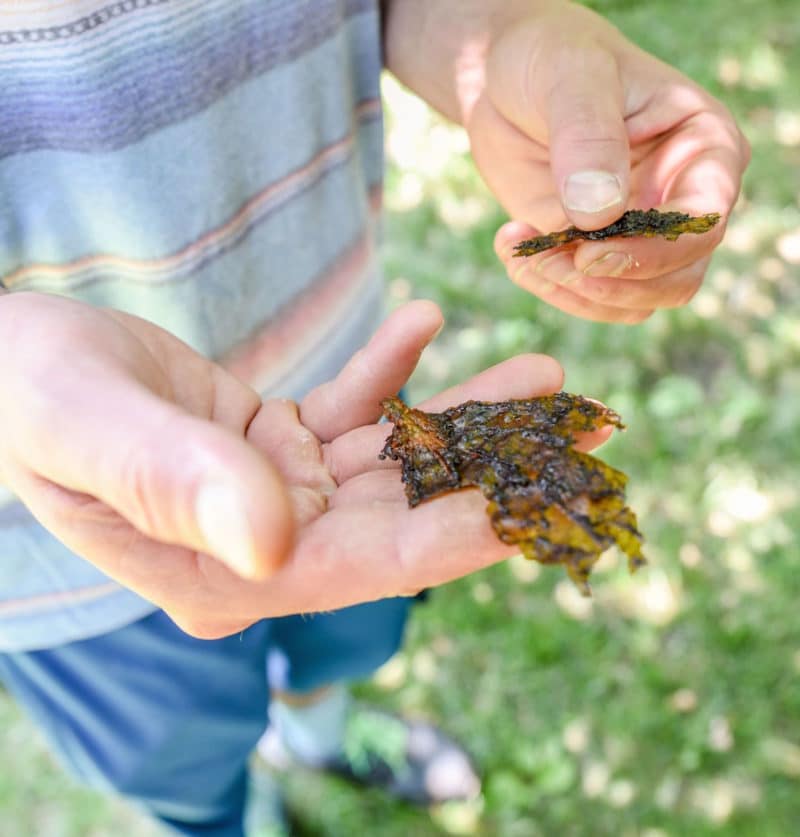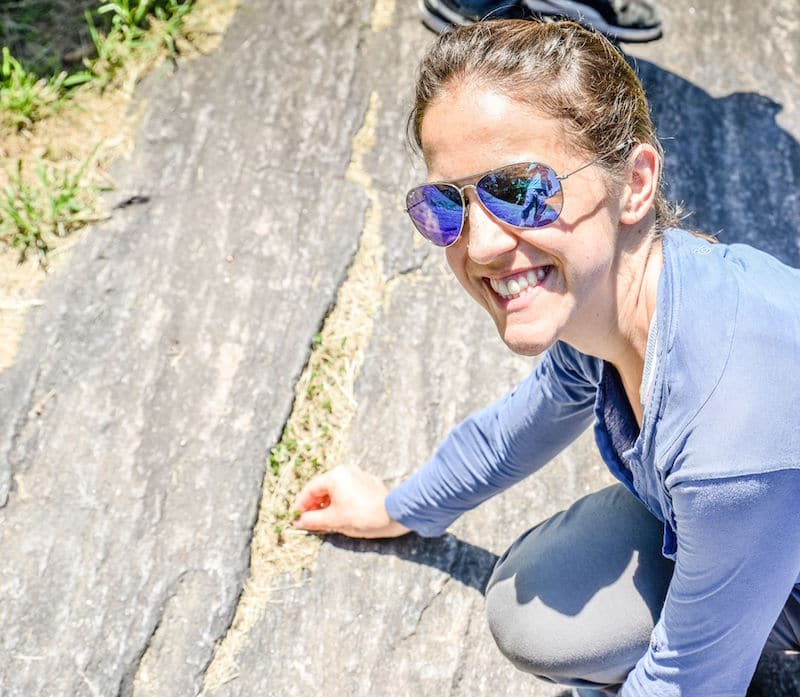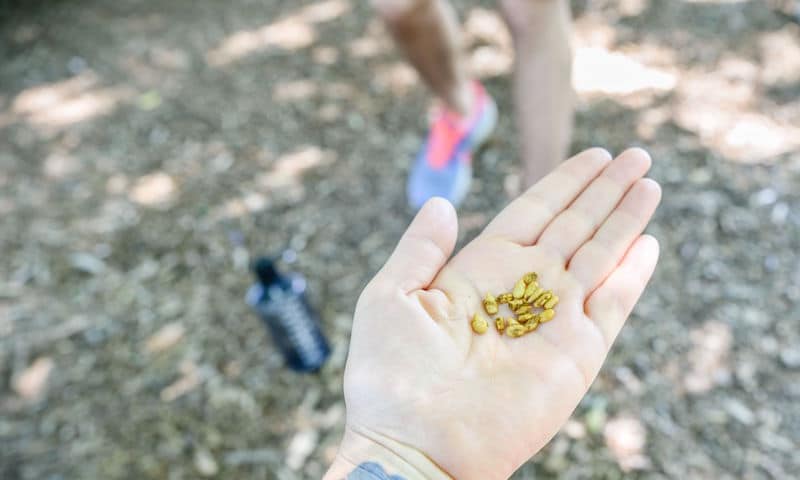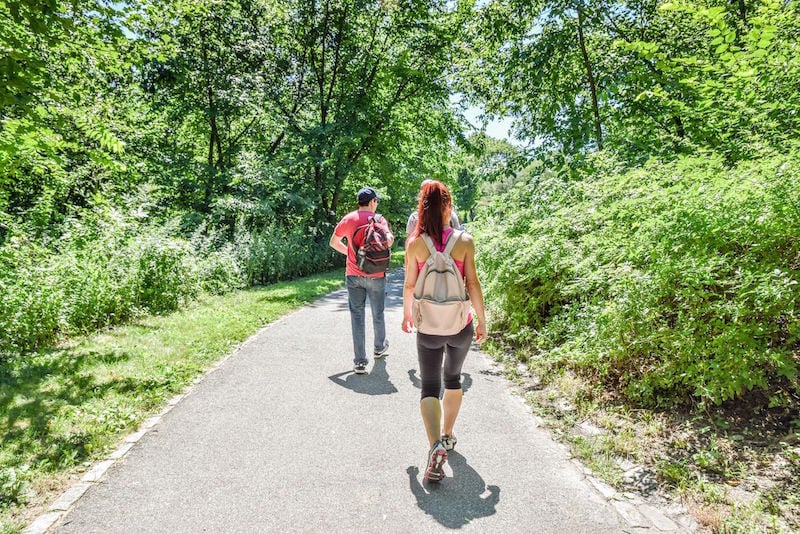How To Forage In NYC’s Central Park (Legally)

Sweet blackberries. Earthy mushrooms. Succulent grasses.
As I view the fresh ingredients, my mouth waters. But I’m not at my local grocery store. Actually, I’m in nature — at Central Park, no less, on a foraging tour.
As a native New Yorker and licensed NYC tour guide I’ve been to Central Park countless times. Bethesda Fountain, Belvedere Castle, Gapstow Bridge, the Jackie Onassis Reservoir and the Hallett Nature Sanctuary are all sites I know well.
But with Steve Brill — aka the Wildman — as my guide we trekked through lush woodland areas and trails lined with thick brush to source what many people don’t even know is edible. The experience is non-touristy NYC at its finest.
Note: Foraging can be very dangerous if you don’t know what you’re doing! It’s important that before eating a plant in the wild you are sure you’ve identified it correctly and aren’t eating something potentially poisonous. This was the main reason I booked a foraging in Central Park tour with Steve. You can also purchase his books:
- Foraging New York: Finding, Identifying, and Preparing Edible Wild Foods
- Identifying & Harvesting Edible and Medicinal Plants (And Not So Wild Places)
- The Wild Vegan Cookbook: A Forager’s Culinary Guide (in the Field or in the Supermarket) to Preparing and Savoring Wild (and Not So Wild) Natural Foods
Steve is an interesting guy, a forager who’s also a vegan chef and an artist. In fact, with each plant we learn about and forage for we see a detailed sketch he’s drawn himself, and taste a recipe from his vegan cookbook.
Additionally, he can play the “Brillophone,” a play on his last name and his talent of creating a drum-like sound by cupping his hands and clapping them in front of his mouth. Tip: if it’s your birthday let him know, as you’ll get a very unique rendition of the classic song.
Digging For Burdock
Immediately, the experience begins with an uphill climb on a dirt path. We’ve barely walked 10 steps before we find our first ingredient of the day: burdock.
This plant is a root vegetable that grows deep underground, so we need shovels to forage for it. Loaded with jokes, Steve also shares his views of our current president.
“You’ll need an incantation to get the energy to dig deep enough. Here’s mine: DONALD TRUMP, DONALD TRUMP, DONALD TRUMP!”
Suddenly, the elephant ear-like leaves and purple flower-topped burrs that sat above the surface come loose. This is followed by an attached slender root vegetable — it looks like a potato but is actually related to the artichoke. Steve smirks, “I guess he’s good for something.”
According to Steve, the flowers that grow atop the burdock — the round fuzzy ones that easily stick to things — were the inspiration for Velcro, and can be used as natural Legos. Not only is burdock fun to play with, its health benefits are vast. It’s a natural diuretic and detoxifier, and is beneficial for people suffering from diabetes, arthritis and skin ailments.
If you like to cook, you can check out Steve’s delicious Vegan Beef Jerky recipe here, which incorporates burdock.
The group continues on, winding through shady paths that silence the honking cars just beyond the park’s border. It’s hard to believe just moments ago I was at a busy intersection, when now it’s so peaceful.
Common (Not Banana) Plantains
We stop in a grassy field surrounded by trees. Here we’ll be foraging for plantains.
No, not the banana-like kind. These are called common plantains, and I recognize them as the “weeds” my parents hate in their yard. They grow prevalent in sunny, grassy areas, and can be identified by their wide ovate green leaves with parallel veins and a waxy texture, growing in a basal rosette on the ground.
I can’t wait for my next picnic in Sheep’s Meadow to impress friends with my new foraging knowledge. Common plantains can be used to help with the itching, rashes, and stings caused by bug bites.
They can be used for cooking, too. Steve actually bakes them into chip form; white miso and ginger laced with herbs like rosemary, thyme and nutmeg. Click here for the recipe.
Poison Ivy, Oh My!
After savoring some more tasty plantain, the group is led to a less beloved plant: poison ivy. Known for its three leaves with pointed tips, they’re actually quite beautiful — green in spring then turning red and orange in autumn.
Interestingly, there’s a plant called jewelweed that’s used to combat poison ivy rashes. Again, the power of nature is very apparent on this tour.
Steve gives us one last (comical) warning. “It’s important to never burn poison ivy because if you inhale it you can die. There’s also one very famous person who isn’t susceptible to it.”
He pauses.
“Bill Clinton, because he doesn’t inhale!”
He continues to tell us that despite how much Americans hate this native plant, gardeners from other countries like Germany and Australia imported it due to its beautiful shiny red and orange hues. They wanted to have the most beautiful garden in their community (ugh!) and then had to have it eradicated (duh!).
Medicine Grass
Now I’m a big fan of salad, so I was happy to move from the poison ivy to purslane.
Yum! It’s high in Omega-3 fatty acids and calcium, not to mention its an anti-inflammatory.
“Some people get this mixed up with dogweed, but it’s different as purslane has a fat red stem. Plus, dogweed tastes like shoe leather.”
Purslane, with its sweet lemony taste, definitely does not taste like shoe leather. I can’t wait to put it in my salad. Steve also recommends using it for potato salad. He uses potatoes, scallions, celery and mayo laced with purslane for a new twist on the old-time side. You can grab the full recipe here (scroll down to “P” for purslane).
Picnic Lunch
The group stops for lunch in a shady area, our meals a mixture of store-bought sandwiches, foraged ingredients and Steve’s curried sunflower seeds. They’re, not surprisingly, quite addictive, and inspire me to spend more time in the kitchen getting more creative than “eggs with cheese.”
“Here you’ll find the rare species of the working toilet,” Steve jokes, as the group happily runs over for a bathroom break.
A Tree Never Forgets
We eat up and replenish our bottles with fountain water before continuing on for the second half of the tour.
Strolling under a slim tree dangling fan-shaped leaves and small round nut-like things, Steve points them out.
“Now come on a tour with me in the fall and we’ll see these in season. They’re… ummm… what do you call them?…”
“Ginkgo Biloba?” asks one of the more nature-savvy guests.
“Ah, I need them for my memory,” smirks Steve.
Note: despite the photo of my fellow tour-goer picking gingko with his bare hands, some people do experience an allergic reaction to it on their skin. Wear gloves to avoid this as well as having your hands smell like the stinky fruit. Inside there’s a nut with a kernel, similar to a pistachio. That kernel is what you’re really wanting to eat.
Nature’s Fruit
Sweet fruits are also part of the foraging experience. While most of the blackberries we find aren’t quite ripe enough for picking — many are hard to pull off the vines and have red in them — the black cherries are tasty. Some are on the more bitter side, though others come from branches that get more sunlight and therefore have more large berries and are sweeter.
Again, it’s important to look at features.
“Notice how these have orange hairs under the leaves? That’s how you tell them apart from the chokecherry, which can kill you.”
Good to know.
The trees also tend to be medium in size with cracked bark. If you peel back the bark — which we don’t because it could harm the tree — you’d find a layer that can be boiled to cure coughs.
In fact, you know how most cough medicine is cherry flavored? That’s because for a very long time — even after we moved from natural to western medicine — people did not believe cough medicine worked unless it had cherry in it.
Oh, Sassafras!
Further into the park we venture, moving from out in the open into a thicket of brush. Here is where we find loads of sassafras, a fragrant tree with three different kinds of leaves. The leaves are great for tea, along with another drink favorite.
Steve pulls out some sassafras by the root, pours water on it to clean it and has us inhale.
Root beer, we all agree. Steve suggests boiling the root to make tea. Or, to make root beer, chill the tea and add honey and sparkling water. Many even add burdock root to their homemade root beer recipe.
Sassafras is also apparently a great detoxifier for the liver, and just one root can be used over and over again. Funny enough, though, it’s not FDA approved.
“Studies have shown that if you drink the equivalent of 400 cups of sassafras every single day for just two years, and are a rat, you may have an increased chance of liver cancer.”
Steve points out that a bottle of beer has way more known carcinogens than sassafras — especially in humans who actually benefit from sassafras (vs rats).
“It just shows you that there’s more beer lobbyists than sassafras lobbyists, and that there are a lot of rats in the FDA.”
It’s also the starting point for the production of ecstasy.
Yes, you read that right.
It’s funny how just a few recipe tweaks can turn your detoxifying tea into a potent party drug.
Want To Be A Murderer?
And yes, you also read that right.
Suddenly, Steve hand-picks some large leaves that look scarily like a common yard plant.
“Hey kids, what do you want to be when you grow up?” Steve asks.
“A science teacher!”
“A fire fighter!”
“A chef!”
All great answers; though not what Steve has in mind. “Oh! Well, I have a great plant for those who want to be a murderer — white snakeroot.”

While I’m happy none of the kids are being primed for a future serial killer resume, I’m curious about this plant (photo here), which apparently killed Abraham Lincoln’s mother, Nancy Hanks Lincoln, in 1818.
It has an insanely interesting backstory.
While it’s rare today for people to die of Milk Sickness, during the early 19th century it claimed many lives as people had no idea why sometimes milk would kill you and other times it didn’t. A female scientist named Anna Pierce Hobbs Bixby set out to find the answer, consulting a Shawnee medicine woman who told her about the white snakeroot. After some experimentation, she found it was indeed the cause.
Not surprisingly, the finding was inconvenient, as it meant a lot of work to ensure the cows no longer grazed on the white snakeroot. And so, many (the “Donald Trumps of the world,” as Steve puts it) simply called Dr. Anna a crazy woman. By the time of her death around 1869 she hadn’t even received formal credit for her discovery and has no idea how she’s praised today.
Death By Happiness
Not all dying is bad. In fact, according to Steve you can actually “die of happiness” from eating yellow wood sorrel. Having too much really isn’t so bad though, as it’s loaded with Vitamin C and tastes like lemonade. It actually looks just like a clover, though the leaves are more heart-shaped.
I put some in a Tupperware for my salad.
I’d like to die of happiness, please.
My true happiness, though, comes from the garlic mustard. Amazingly, this plant protects itself from insects by smelling like garlic — unless they’re “Italian insects,” as Steve jokes.
But seriously, how could any creature not love garlic?!
Removing the white cross-shaped flowers, the group crunches the sticks up to have small black seeds left in our palms. While the seeds are tasty on their own, Steve pulls out a homemade pesto (recipe here) that’s even tastier.
As I savor the slightly spicy dip atop a whole grain cracker, I’m in awe. I can’t believe these simple white flowers — ones I never would have known were an actual culinary ingredient — could lead to such deliciousness.
Sticks, Anyone?
As we walk deeper into Central Park’s North Woods — a protected area known for its bird life — we move from leafy greens to more woody bites. Steve begins to quiz the group as we walk along a wooded path, keeping our eyes peeled for food. He points to a nearby tree and asks, “What color is this bark?”
Grey.
“Is it smooth or rough?”
Smooth.
“What kind of markings does it have?”
Horizontal lines.
“Now the question is what does it smell and taste like.”
Soon, he’s breaking off the thin branches, removing the leaves and passing around samples. It’s black birch, used by the Native Americans as chewing gum. As I bite into the wood, I savor the fresh wintergreen flavor. Interestingly, it’s also a low dose aspirin that’s great for children who aren’t old enough to have painkillers, like teething babies. And it’s abundant in US parks that aren’t near shorelines; right there waiting to be picked.
Dipping into his backpack, Steve pulls out a Tupperware of what he calls “Stick Pudding.” While the name doesn’t sound the most appetizing, the snack is delicious. It’s a foraged alternative to typical tapioca, featuring stevia and raisins for sweetness as well as black birch, cinnamon and vanilla beans. The sticks and beans are removed before serving. It’s a delicious dessert.
Coffee Beans In Central Park?!
My favorite treat of the day ends up being Steve’s truffles. The decadent chocolates feature beans from the Kentucky coffee-tree, which grows in Central Park, as well as Prospect Park and just outside of Inwood Park.
Steve explains that he roasts the tree pod’s seeds — which taste like coffee — and mixes them with unsweetened cocoa, dates, almonds, cocoa powder, vanilla, melted unsweetened dark chocolate and stevia to sweeten. The ingredients are blended and rolled up into rich balls that are then dusted with carob powder.
So good! And I don’t even feel guilty. Apparently just two seeds can make 30+ truffles, so you don’t need to go crazy trying to forage for a ton of them.
It’s definitely a sweet ending to the day, which has become one of my favorite. I really think this is one of the top things to do on the Upper East Side NYC.
Foraging in Central Park Tour Ethics
The foraging tour in Central Park focuses on ethics in a number of ways. For one, Steve instructs us to eat only renewable plants, reminding us to leave the roots in for most of our picks. Additionally, he promotes vegan cooking throughout the tour, allowing us to sample dishes he makes at home using what we’ve picked.
Is It Legal?
For anyone wondering how Steve gets away with picking and eating plants from the parks, the story is ironic.
In March 1986 Steve was arrested and handcuffed by Central Park rangers, who’d gone undercover on his tour.
“I got so much PR that the Parks Department hired me to teach foraging in June of 1986. I quit in June of 1990 when the new Parks Commissioner, Betsy Gotbaum, reneged on the verbal terms of the agreement I had with the previous administration, and tried to get me to stop teaching foraging.”
A decade later, Parks Commissioner-to-be Adrian Benepe invited Steve to his office at the NY Botanical Garden, told him he admired his work, and revealed the true reason of Steve’s arrest: collective administrative paranoia that someone pretending to have been poisoned would sue the city and cite Steve as evidence that foraging was allowed.
“That’s still the real reason they hate foraging today. Giving a false reason for an arrest — I was charged with removing vegetation from the park, not inspiring frivolous lawsuits — is official wrongdoing. It’s called false arrest. I wish they’d do it again!”
Today Steve — and his daughter — do have permission to forage. For anyone else, foraging in Central Park is against park regulations, though not against the law.
Notes Steve, “So is removing colored autumn leaves by kindergarten kids, and it’s up to officials to determine whether such an activity is harmful or not, although they’re more interested in covering themselves legally than anything else.”
Foraging in Central Park is one of the top things to do in Upper Manhattan and is one of the best things to do in NYC in spring. Here are 40 more.
Hotels In New York City
Looking to stay overnight in NYC?
There are so many incredible hotels, like NoMo SoHo, the Williamsburg Hotel, and The Ludlow.
Click here for a full list of New York City hotels!
Prefer self-contained stays?
You can also use this map to search for unique local rentals. It’s currently set to Times Square, but you can easily change it to your desired NYC neighborhood:
Like the idea of hotel living? There are also many live-in hotels in NYC that offer extended stays
Have you ever gone foraging in Central Park or elsewhere?

Hi, I’m Jessie on a journey!
I'm a conscious solo traveler on a mission to take you beyond the guidebook to inspire you to live your best life through travel. Come join me!

Want to live your best life through travel?
Subscribe for FREE access to my library of fun blogging worksheets and learn how to get paid to travel more!




























Thanks for the great article. A couple of corrections, though:
1. The non-edible plant that looks like purslane, although it has wiry, not succulent, stems, plus alternate (single) leaves, not opposite (paired) leaves, is doorweed, not dogweed.
2. Choke cherries, the look-alikes to blackberries, rare in and around NYC, aren’t poisonous. They’re just so astringent raw (but quite good cooked) that they’ll make you wish you were dead!
I’d also like to add that Blackberries have become increasingly rare over the last 10 years. That’s because of too much competition from the iPhone! (-:
I’m excited that I came across your page. I’m from London, England and have my own allotment, I’m used to foraging wherever I can without terrible worry. I’m looking forward to foraging in Central Park and intend on dragging a New Yorker friend with me to open her eyes up to the beauty and the tremendous usefulness of nature.
Thank you again
@Sadiki: Incredible! And you’ll love Steve. He’s a GREAT guide who knows everything it seems on foraging.